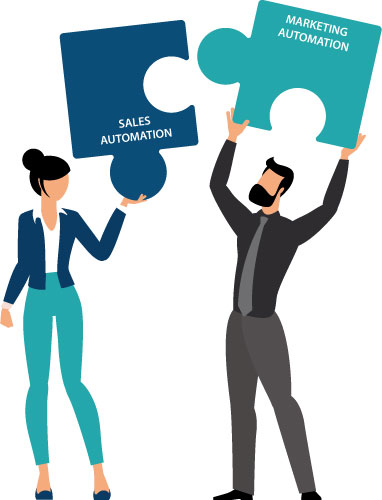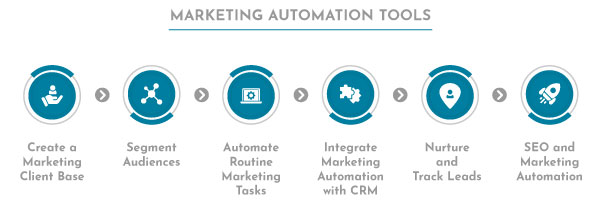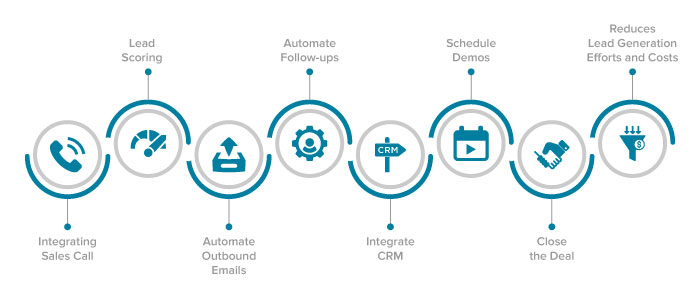Difference Between Sales and Marketing Automation and its Importance.
Sales and marketing automation– both are different tools but play a pivotal role in running a business. A business starts with a marketing process and concludes with a sales process. They are yin and yang of a company. One complements the other perfectly.
An organization survives on both the processes to yield maximum revenues. Both play an essential role in the existence of a business. One differs a lot from the other. Therefore their automation also varies.
The essential base of a marketing process and communication is to create marketing campaigns based on customer’s demands and needs. It involves gathering information about the customer and engaging them on the respective basis such as their age or demographical factors. The marketing automation process is about building a customer’s persona and satisfying them to the tee. It involves nurturing and analyzing leads and potential clients based on their behavior and actions. The purpose is to target a more significant part of the audience.

On the other hand, the sales process is all about personalization. It involves collecting information about the customers to boost your sales somehow. You must analyze the data to attain more conversions. The sales automation process is not about a larger audience, but the focus is on a customer individually and striving to turn them into customers.
The significant difference between sales and marketing is that the sales process involves outbound strategies, whereas marketing is more about evaluating your leads and readying them up for sales.
ROLE OF SALES AUTOMATION AND MARKETING AUTOMATION TOOLS :
You can automate all of the above aspects of marketing and sales processes with the help of specific tools. These tools fasten up the process of sales and marketing processes and allow both the teams to focus on core sales and marketing activities. Let us know the effectiveness of these tools and how they impact the work progress :
1. Marketing automation tools :

- Create a marketing client base: The first and foremost rule of creating a marketing strategy is to have a solid client base. Before you go on with multiplying your services, it’s essential to focus on the service itself. Create a marketing persona and know your targeting market. Consider all the factors, start affiliating with the clients, and strengthen your bond with them.
- Segment audiences: Once you know what your targeted audience is. Segment them based on their preferences, interests, and behavior. Know what actions they are performing on your site, such as views and clicks on different sections.
- Automate routine marketing tasks: The most significant benefit of marketing automation is to automate mundane tasks such as creating and automating content for social media posts despite setting the content manually. Also, you can use email autoresponders and trigger users to perform actions. At the same time, you can engage users based on their performed actions.
- Integrate marketing automation with CRM: CRM with marketing automation allows you to collect relevant customer data and engage them on its basis. You can get all the insights about the customers and build relevant campaigns on its grounds.
- Nurture and track leads: An efficient marketing automation platform allows you to identify the elements of your content marketing strategy as to what is driving more conversion rates and revenues and click through rates. By evaluating the click-through rates, you can surely notice what is to capture leads so that you can take further actions to convert them into visitors.
- SEO and marketing automation: Many companies fail to understand that SEO plays a significant role in marketing automation as it indirectly or directly helps in nurturing leads.
Until and unless you are not aware of what keywords are compelling the leads and turning into conversions, you cannot get effective productivity. Once you know the relevant keywords, you can form marketing campaigns and draw in qualified leads through marketing automation.
2. Sales automation tools :

- Integrating sales call: Sales automation tools help your sales team achieve efficiency. The tools help in recording and analyzing the calls. The teams can use transcribing services to convert audio files into a text. The sales team can automate processes such as complaints analysis and repeat call analysis.
- Lead scoring: Filter the leads based on their interests and preferences. Allot the score to the leads who are more likely to mature. Prioritize the mature leads and engage them more to let them convert.
- Automate outbound emails: Just like inbound emails, you can automate the outbound email system, too, instead of burdening your sales representative with the tasks of sending emails manually. The whole process can be automated. This way, you can engage potential customers based on statistics.
- Automate follow-ups: Sales teams can use the filters criteria to dissect the potential customers and clients from the unrequired ones. It will help you achieve successful conversions when your sales team can follow-up only those customers who show interest.
- Integrate CRM: When you integrate CRM with sales automation, there is no chance, you will miss out on any of the leads. You can automate the lead prioritization by automating the whole sales process. Your teams can receive real-time alerts about leads, such as what actions they are performing and how likely they turn into conversions.
- Schedule demos: Once you know the leads, you can engage them through demo automation. It means you can create content based on a prospect’s interests. Through automation, the sales representatives can get notified when the leads have watched the demo and how far they are engaging. Getting these analytics will help you to enhance your user experience and engagement.
- Close the deal: You can finally analyze the leads who are interested in your product with the help of real-time insights, and by knowing them, you can reach up to them with relevant offers and close the deal. You can additionally use a incentive compensation management software to automate calculating commissions for sales teams.
- Reduces lead generation efforts and costs: Finally, you can conclude that you can automate the whole process and save up your time in managing the trivial tasks. Apart from time, sales automation is cost-effective.
Now that we have discussed the role of marketing automation and sales automation tools in your business. It’s the time to decide which one you need and what offers you the best results.
SALES AND MARKETING AUTOMATION – WHICH ONE YOU NEED?
- It would be foolish to choose one between the two. Both are equally beneficial to the business. But if you want to consider which one you need to begin with, it would be better if you analyze all your goals, priorities, and current sales performance

- As stated above, you will need both the automation processes as both are equally important to yield good results. In case you still choose one to get the results of both, you can land in trouble.
Note: According to a statistical survey, marketing automation software is not ideal for every stage of your funnel
How to choose the automation process accordingly :
Which automation is right for which task :
Marketing automation provides you efficient results when you are targeting your existing customers and potential customers. Your marketing strategy specifically revolves around the customer’s expectations. But you can only offer customers whatever services you offer.
You can enhance your services but cannot change it. Marketing automation improves the efficiency of the marketing processes, on the other hand. For example, – If a visitor signs up for emails, an automated system will automatically add the customer to the list. Also, through email automation, they will be triggered further so that the lead turns into a conversion.
The sales automation process is about engaging customers on an individual level. You have to ensure that each buyer is managed differently based on their persona. The process gets a bit different because now you need to discover each potential customer based on specific information. Currently, you are developing sales at a much higher pace.
Note: Online marketing allows marketers to reach a larger audience and not the other way round. That is how marketing automation enhances productivity and helps you deliver relevant content to the customers so that you can rectify your strategies accordingly.
Points to remember during the sales and marketing automation process :
- The main motive of sales automation is to automate the functionalities of the sales department; at the same time, you must not miss the human element in it. If you follow this rule, you will surely get effective results.
- You must strive to automate both sales and marketing processes to get beneficial results. It’s essential to achieve the results as you expected. Also, sales automation is incomplete without human resources. The contagious benefits of automation are it reduces the risk of errors because each stage is analyzed deeply to assure you have invested all the elements into the process.
CONCLUSION
Your sales team cannot achieve high conversions merely with the help of marketing automation. The sales team must design an effective marketing and sales strategy to get higher revenues, and no doubt, sales automation helps them perform the same. Sales automation makes your targeting more effective with personalization.
